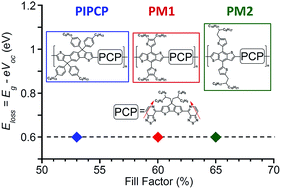Influence of molecular structure on the performance of low Voc loss polymer solar cells†
Abstract
Two regioregular narrow bandgap conjugated polymers (PM1 and PM2) containing the repeat unit BDT-PT-CPDT-PT (BDT = benzodithiophene, PT = pyridyl[2,1,3]thiadiazole, CPDT = cyclopentadithiophene) and different solubilizing alkyl side chains were prepared with the goal of understanding how chemical structure impacts the performance of low Voc loss bulk heterojunction (BHJ) solar cells containing PC61BM as the acceptor semiconductor. Both polymers show nearly identical orbital energy levels, a face-on orientation relative to the surface normal, and can be processed to yield continuous fiber-like networks in the active layer. Due to the choice of repeat units within the backbone structure, PM1 and PM2 exhibit shorter π–π stacking distances, relative to the previously reported low Voc loss regioregular polymer PIPCP. Finally, PM1 achieves an average PCE of 6.2 ± 0.2% and PM2 achieves an average PCE of 7.2 ± 0.1%. Devices exhibit low Voc loss and high short circuit current Jsc, but, most significantly, display improved fill factors compared to previously reported PIPCP. A discussion is provided that seeks to identify structural features in conjugated polymers that lead to devices with low Voc loss and high external quantum efficiencies.


 Please wait while we load your content...
Please wait while we load your content...